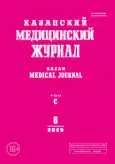Анкетно-биомаркёрная оценка риска пагубного употребления алкоголя у учащихся, получающих медицинское профессиональное образование различного уровня
- Авторы: Индутный А.В.1, Новиков Д.Г.1, Самусева Н.Л.1, Тагаков К.С.1
-
Учреждения:
- Омский государственный медицинский университет
- Выпуск: Том 100, № 6 (2019)
- Страницы: 910-917
- Тип: Теоретическая и клиническая медицина
- URL: https://ogarev-online.ru/kazanmedj/article/view/18508
- DOI: https://doi.org/10.17816/KMJ2019-910
- ID: 18508
Цитировать
Полный текст
Аннотация
Цель. Сравнить результаты анкетно-биомаркёрной оценки риска пагубного употребления алкоголя у учащихся, получающих высшее и среднее медицинское профессиональное образование.
Методы. У здоровых 18–27-летних учащихся, получающих высшее и среднее медицинское профессиональное образование (77 и 124 человека соответственно), в сыворотке крови исследовали активность индикаторных ферментов, а с помощью анкет-опросников определяли риск пагубного употребления алкоголя (анкеты CRAFFT, CAGE, AUDIT) и психологические особенности личности (тест-опросник волевого самоконтроля А.Г. Зверькова, Е.В. Эйдмана, опросник самоконтроля Р. Баумайстера, тест жизнестойкости — методика С. Мадди в адаптации Д.А. Леонтьева, методика для выявления импульсивности С. Баррата, методика выявления групп риска по употреблению психоактивных веществ в образовательном учреждении). Статистическую значимость различий оценивали с использованием непараметрических критериев.
Результаты. Активность ферментов (аспартатаминотрансферазы, аланинаминотрансферазы, γ-глутамилтранспептидазы) в крови обследуемых не имела существенных межгрупповых различий. Мы дополнительно (вне данного исследования) охарактеризовали базу данных лабораторных обследований учащихся в возрасте 18–27-лет, обратившихся за лабораторно-медицинской помощью в академический центр лабораторной диагностики Омского государственного медицинского университета. Из 646 обследуемых у 52 (8,1%) данные лабораторные показатели выходили за пределы референтного интервала, так что можно было ожидать различий. Отсутствие превышения порога референтных значений со стороны активности исследуемых ферментов необходимо в нашей работе для подтверждения отсутствия как патологии с явлениями цитолиза, так и признаков хронического употребления алкоголя с вредными для здоровья последствиями, что эквивалентно соблюдению принятых критериев включения (отсутствие патологии на основании врачебного профессионально-консультативного заключения по форме 086/у и по результатам прохождения периодического медицинского осмотра). Среди всех обследуемых анкета CRAFFT показала в 2,7 раза бόльшую численность группы риска пагубного употребления алкоголя, чем CAGE, и в 1,4 раза — чем AUDIT. Результаты тестов-опросников CAGE и CRAFFT продемонстрировали бόльшую распространённость риска пагубного употребления алкоголя у студентов, обучающихся по программам высшего медицинского образования, в сравнении с учащимися, получающими среднее медицинское образование (CAGE — в 2,7 раза, CRAFFT — в 1,68 раза). Тест AUDIT статистически значимых различий между группами не выявил (p=0,093). Анализ результатов психологического тестирования по выявлению склонности к аддиктивному поведению, показал слабую корреляционную взаимосвязь c уровнем самоконтроля (r=–0,406, p=0,014 и r=–0,313, p=0,016 для тестов CRAFFT и AUDIT соответственно). Корреляция между нарушением самоконтроля и риском пагубного употребления алкоголя, как показало исследование, достаточно слабая, следовательно, учащиеся с нарушенным самоконтролем далеко не всегда характеризуются алкогольной мотивацией. В контексте полученных нами данных психологическое анкетирование для мониторинга риска пагубного употребления не способно заменить тесты CRAFFT и AUDIT.
Вывод. Анкета CRAFFT наиболее результативна при оценке риска пагубного употребления алкоголя у обследуемого контингента молодёжи; результаты использованных опросников слабо коррелируют с тестами, отражающими психологические особенности личности; активность исследуемых ферментов в сыворотке крови не коррелирует с результатами анкетных методов исследования и находится в пределах популяционного референтного интервала.
Ключевые слова
Полный текст
Открыть статью на сайте журналаОб авторах
Антон Васильевич Индутный
Омский государственный медицинский университет
Email: novikov.dm.omsk@gmail.com
SPIN-код: 5458-0238
Россия, г. Омск, Россия
Дмитрий Георгиевич Новиков
Омский государственный медицинский университет
Автор, ответственный за переписку.
Email: novikov.dm.omsk@gmail.com
SPIN-код: 1894-0582
Россия, г. Омск, Россия
Наталья Львовна Самусева
Омский государственный медицинский университет
Email: novikov.dm.omsk@gmail.com
SPIN-код: 1319-6308
Россия, г. Омск, Россия
Кирилл Сергеевич Тагаков
Омский государственный медицинский университет
Email: novikov.dm.omsk@gmail.com
Россия, г. Омск, Россия
Список литературы
- Lester L., Baker R., Coupland C., Orton E. Alcohol misuse and injury outcomes in young people aged 10–24. J. Adolesc. Health. 2018; 62 (4): 450–456. doi: 10.1016/j.jadohealth.2017.10.003.
- Patton R., Deluca P., Kaner E. et al. Alcohol screening and brief intervention for adolescents: The how, what and where of reducing alcohol consumption and related harm among young people. Alcohol Alcoholism. 2014; 49 (2): 207–212. doi: 10.1093/alcalc/agt165.
- Зверьков А.Г., Эйдман Е.В. Исследование волевой саморегуляции. Психологические методики изучения личности. М.: Ось-89; 2008. http://testoteka.narod.ru/lichn/2/05.html (дата обращения: 29.06.2019).
- Pilowsky D., Wu L. Screening instruments for substance use and brief interventions targeting adolescents in primary care: A literature review. Addict. Behav. 2013; 38 (5): 2146–2153. doi: 10.1016/j.addbeh.2013.01.015.
- Nanau R.M., Neuman M.G. Biomolecules and biomarkers used in diagnosis of alcohol drinking and in monitoring therapeutic interventions. Biomolecules. 2015; 5 (3): 1339–1385. doi: 10.3390/biom5031339.
- Niemelä O. Biomarker-based approaches for assessing alcohol use disorders. Intern. J. Environmen. Res. Public Health. 2016; 13 (2): 166. doi: 10.3390/ijerph13020166.
- Källmen H., Berman A.H., Jayaram-Lindström N. et al. Psychometric Properties of the AUDIT, AUDIT-C, CRAFFT and ASSIST-Y among Swedish Adolescents. Eur. Addict. Res. 2019; 25 (2): 68–77. doi: 10.1159/000496741.
- Baumeister R., Heatherton T., Tice D. Losing control. San Diego: Academic Press. 2006; 157 р.
- Леонтьев Д.А., Рассказова Е.И. Тест жизнестойкости. М.: Смысл. 2006; 63 с.
- Lange F., Wagner A., Müller A., Eggert F. Subscales of the Barratt Impulsiveness Scale differentially relate to the Big Five factors of personality. Scand. J. Psychol. 2017; 58 (3): 254–259. doi: 10.1111/sjop.12359.
- Рожков М.И., Ковальчук М.А. Профилактика наркомании у подростков. М.: Гуманитарный издательский центр ВЛАДОС. 2004; 144 с.
- Andresen-Streichert H., Müller A., Glahn A. et al. Alcohol biomarkers in clinical and forensic contexts. Dtsch. Arztebl. Int. 2018; 115 (18): 309–315. doi: 10.3238/arztebl.2018.0309.
- Santangelo O.E., Provenzano S., Piazza D. et al. Factors associated with risky consumption of alcohol in a sample of university students. Ann. Ig. 2018; 30 (6): 502–508. doi: 10.7416/ai.2018.2261.
Дополнительные файлы






